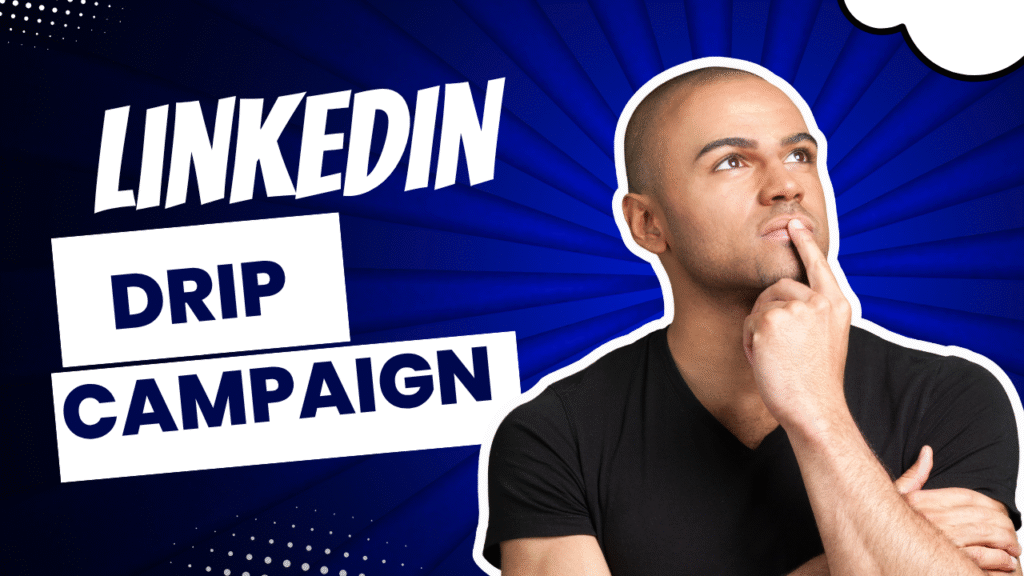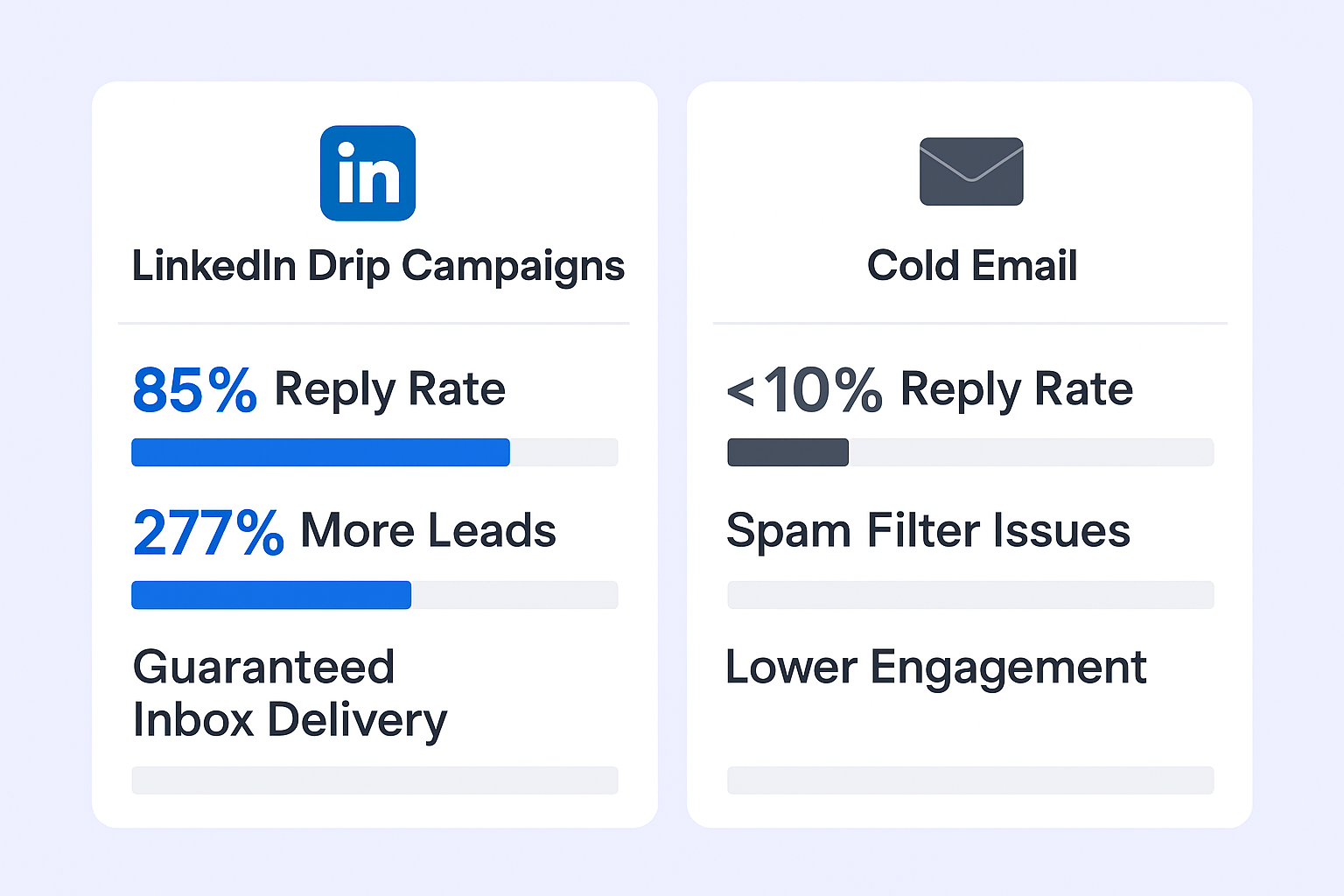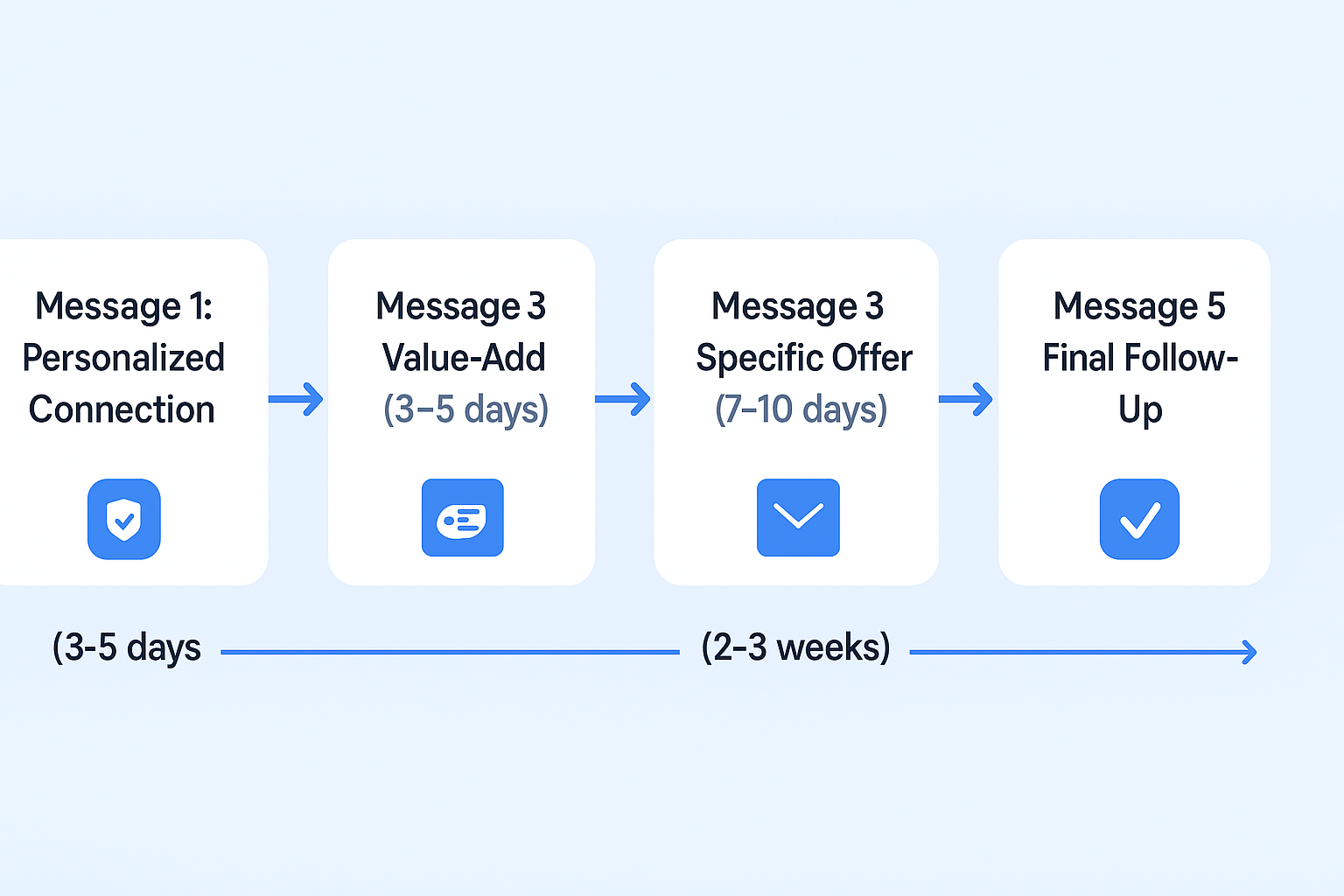- blog
- Lead Generation
- LinkedIn Drip Campaign Guide: Cold Outreach Success Tips

Master LinkedIn Drip Campaigns: Your Complete Guide to Cold Outreach Success
Table of Contents
Picture this: You send a perfectly crafted LinkedIn message to your dream prospect. You wait. And wait. Nothing. Sound familiar?
Here’s the truth that will shock you: 85% of LinkedIn messages get replies – that’s 3x higher than traditional email. But most people are doing it completely wrong.
The game isn’t about sending one perfect message. It’s about creating a strategic sequence that builds relationships, delivers value, and converts prospects into customers. This is where LinkedIn drip campaigns come in.
What is a LinkedIn Drip Campaign?
A LinkedIn drip campaign is a strategic sequence of automated messages designed to nurture prospects over time on LinkedIn. Unlike single outreach attempts, these campaigns involve multiple touchpoints that gradually build relationships and guide prospects toward a specific action.
Think of it as a conversation roadmap. Each message serves a purpose – whether it’s making a connection, providing value, or making a soft ask. The “drip” refers to the steady, consistent delivery of messages over days or weeks.
Key components include:
- Personalized connection requests
- Value-driven follow-up messages
- Strategic timing between touchpoints
- Clear calls-to-action (CTAs)
- Automated sequences that mimic human behavior
The beauty of LinkedIn drip campaigns? They leverage LinkedIn’s professional environment while often integrating with email outreach for maximum impact.
Why Should You Create LinkedIn Drip Campaigns?
Unmatched Lead Generation Power
LinkedIn generates 277% more leads than Facebook and Twitter combined. With over 1 billion members globally and 65 million business decision-makers, it’s the ultimate B2B goldmine.
79% of B2B marketers consider LinkedIn an excellent lead source, with 59% confirming it successfully generates leads for their business. These aren’t just vanity metrics – they translate to real pipeline growth.
Superior Response Rates
Here’s where it gets interesting. While LinkedIn reports an 85% average reply rate, real-world cold outreach data shows a more realistic 19.98% reply rate – still double the typical cold email response rate of under 10%.
Even better? 48.14% of LinkedIn replies are positive, meaning prospects are actually interested in continuing the conversation.
Guaranteed Inbox Placement
Unlike emails that battle spam filters, LinkedIn messages land directly in your prospect’s inbox. No deliverability headaches, no wondering if your message was seen.
Relationship Building at Scale
LinkedIn drip campaigns allow you to nurture hundreds of prospects simultaneously while maintaining a personal touch. You’re not just sending
🚀 Drip Campaigns That Actually Work
Complete outbound engine delivers 85% response rates with strategic targeting and campaign frameworks
How to Create a LinkedIn Drip Campaign in 6 Steps
Define Clear Goals & Target Audience
Before writing a single message, get crystal clear on what you want to achieve. Are you booking discovery calls? Driving webinar registrations? Promoting content?
Your goal determines everything else – from your target audience to your message content.
Target audience identification involves:
- Job titles and seniority levels
- Industry and company size
- Specific pain points or challenges
- Geographic location
- Technology stack (if relevant)
Use LinkedIn Sales Navigator to find decision-makers and influencers within your target accounts. The more specific your targeting, the better your personalization and results.
Craft Your Multi-Message Sequence
The magic happens in the sequence. Here’s a proven 5-message framework:
Message 1: The Personalized Connection Request Keep it short and genuine. Mention something specific – a shared connection, their recent post, or company news.
Example: “Hi [Name], I noticed your recent post about [specific topic]. Would love to connect and learn more about your experience with [relevant area].”
Message 2: The Value-Add (3-5 days after acceptance) Provide immediate value without asking for anything. Share a relevant article, industry insight, or helpful resource.
Message 3: The Soft Engagement (7-10 days later) Ask a thoughtful question related to their work or industry. Encourage dialogue rather than pushing for a meeting.
Message 4: The Specific Offer (2-3 weeks later)
Make a low-pressure offer – a quick call, relevant case study, or free resource that addresses their potential pain points.
Message 5: The Final Follow-Up A gentle reminder that maintains goodwill while providing one last opportunity to engage.
Each message should build on the last, providing new value without repetition.
Leverage Automation Tools (Wisely!)
Manual outreach doesn’t scale. Automation tools like Dripify, Expandi, Meet Alfred, and GrowMeOrganic can help you:
- Send personalized connection requests
- Automate message sequences
- Schedule profile visits
- Track campaign performance
Choose tools that:
- Mimic human behavior with randomized delays
- Stay within LinkedIn’s daily limits
- Offer robust personalization features
- Integrate with your CRM
Remember: LinkedIn prohibits automation tools, but many operate safely by mimicking human behavior and staying within reasonable limits.
Personalize Every Touchpoint
Generic messages scream “mass outreach” and get ignored. Effective personalization goes beyond using someone’s first name.
Advanced personalization includes:
- References to specific LinkedIn posts
- Company news or recent achievements
- Shared connections or experiences
- Industry-specific challenges
- Location-based references
Research shows personalized emails generate 6x higher transaction rates, while generic messages can cause a 30% drop in open rates.
Optimize Timing and Frequency
Timing can make or break your campaign. LinkedIn data reveals:
- Mondays have the highest connection acceptance rate (22.04%)
- Thursdays generate the most message replies (20.32%)
- 10:00 AM is the optimal reply time
- Space messages 3-5 days apart to avoid overwhelming prospects
Consider your audience’s time zone, especially for global outreach. Messages that arrive when prospects are most active get better engagement.
Test, Monitor, and Refine Your Campaign
Track these critical metrics:
- Connection acceptance rates
- Message reply rates
- Conversation rates
- Conversion rates (meetings booked, demos scheduled)
A/B test different elements:
- Subject lines and message content
- CTAs and offers
- Send times and frequencies
- Personalization approaches
Use data to continuously refine your approach. Small improvements compound over time.
LinkedIn Drip Campaign Best Practices
Maintain Account Safety
LinkedIn’s terms prohibit automation, but smart practices minimize risk:
- Mimic human behavior with varied timing and realistic activity levels
- Avoid robotic patterns like sending identical messages at the same time daily
- Personalize extensively to avoid spam-like experiences
- Withdraw ignored connection requests to maintain sender reputation
- Choose reputable automation tools that prioritize safety and compliance
Provide Consistent Value
Every message should offer something useful – insights, resources, or solutions to common problems. This builds trust and keeps prospects engaged throughout your sequence.
Use Clear, Compelling CTAs
Guide prospects to the next step with specific, actionable requests:
- “Worth a 15-minute chat this week?”
- “Interested in seeing how [Company] solved this?”
- “Would you like the full case study?”
Weak CTAs confuse recipients and kill momentum.
Optimize for Mobile
Over 60% of LinkedIn traffic comes from mobile devices. Ensure your messages are:
- Easy to read on small screens
- Concise and scannable
- Have thumb-friendly CTAs
Profile Optimization is Critical
Your LinkedIn profile is often the first impression prospects get. Optimize:
- Professional headshot and compelling headline
- Value-focused summary highlighting how you help clients
- Rich media showcasing your expertise
- Recommendations and endorsements for social proof
📈 Strategic Multi-Touch Sequences
LinkedIn campaigns combine drip methodology with proven frameworks for systematic prospect engagement
LinkedIn Drip Campaign Examples
Basic Connection & Nurture Sequence
Day 1: Connection Request “Hi [Name], I saw your insights on [specific topic] and would love to connect. Always enjoy learning from leaders in [industry].”
Day 4: Value Message
“Thanks for connecting, [Name]! Thought you’d find this [industry report/article] interesting given your work in [specific area]. No agenda – just sharing good content.”
Day 11: Engagement Question “Quick question, [Name] – what’s your take on [relevant industry trend/challenge]? Seeing mixed opinions from [industry] leaders.”
Day 25: Soft Offer “Been thinking about our conversation on [topic]. I have a case study showing how [similar company] tackled this exact challenge. Worth a quick look?”
Event Follow-Up Sequence
Day 1: Post-Event Connection “Great meeting you at [Event Name], [Name]! Enjoyed our chat about [specific topic discussed].”
Day 3: Shared Resource “Following up on our [event] conversation – here’s that [resource/article] I mentioned about [topic]. Hope it’s helpful!”
Day 10: Relevant Insight
“Saw this article about [event topic] and remembered our discussion. Thought you’d appreciate the data on [specific point].”
Day 21: Meeting Request “Would love to continue our conversation from [event]. Free for a quick 15-minute call next week to discuss how this applies to [their company]?”
Multi-Channel LinkedIn-Email Sequence
Day 1: LinkedIn Connection Request “Hi [Name], noticed you’re leading [department] at [Company]. Would love to connect!”
Day 3: LinkedIn Value Message “Thanks for connecting! Sharing a quick insight about [relevant topic] that might interest you.”
Day 8: Email Follow-Up (if no LinkedIn reply) Subject: “Quick question about [their industry challenge]” “Hi [Name], following up on my LinkedIn message. Noticed [Company] is focusing on [initiative]. Have you considered [relevant approach]?”
Mistakes to Avoid When Running LinkedIn Drip Campaigns
Overloading Recipients (Frequency Fatigue)
Sending too many messages too quickly overwhelms prospects and damages your reputation. Stick to 3-5 day intervals and respect your audience’s time.
Neglecting Deep Personalization
Generic templates are immediately recognizable and get ignored. Take time to research each prospect and reference specific details about their work, company, or industry.
Weak or Missing CTAs
Every message should guide prospects toward a specific next step. Vague endings like “Let me know what you think” don’t drive action.
Ignoring Analytics & Testing
Flying blind without tracking performance metrics means missing optimization opportunities. Monitor your numbers and test different approaches continuously.
Additional critical mistake: Using aggressive automation that triggers LinkedIn’s spam detection. This can result in account restrictions or bans that damage your professional presence.
Key Points for LinkedIn Drip Campaign Success
- Define clear goals before creating any messages
- Target precisely using specific criteria and LinkedIn Sales Navigator
- Sequence strategically with 4-7 messages spaced 3-5 days apart
- Automate smartly with tools that mimic human behavior
- Personalize deeply beyond basic name insertion
- Optimize timing for maximum engagement
- Monitor and refine based on performance data
Success comes from consistent execution of these fundamentals, not complex strategies or magic tricks.
⚡Scale Your LinkedIn Sequences
Professional outbound strategy delivers consistent results with systematic targeting and scaling methods
7-day Free Trial |No Credit Card Needed.
Frequently Asked Questions
Q: What is the ideal length and frequency for LinkedIn drip campaigns to maximize response rates?
How often should messages be sent in a LinkedIn drip campaign?
Can automation tools be used safely on LinkedIn?
What is a good connection acceptance rate on LinkedIn?
What is a good reply rate for LinkedIn messages?
Conclusion
LinkedIn drip campaigns represent one of the most powerful tools in modern outreach. With 277% more leads than other social platforms and 3x higher response rates than email, the opportunity is massive.
But success isn’t about automation or volume – it’s about building genuine relationships through consistent value delivery. The best campaigns combine strategic sequencing, deep personalization, and perfect timing to guide prospects from connection to conversion.
Start with clear goals, target precisely, and focus on providing value at every touchpoint. Test continuously, respect LinkedIn’s guidelines, and remember that behind every profile is a real person looking for solutions to their challenges.
Your next breakthrough client might be just one personalized connection request away. The question isn’t whether LinkedIn drip campaigns work – it’s whether you’re ready to implement them correctly.
Ready to transform your outreach? The tools, strategies, and examples are all here. Now it’s time to execute.

Beyond Basic Drip Campaigns
Strategic LinkedIn outbound combines proven sequences with systematic targeting and scaling methods
